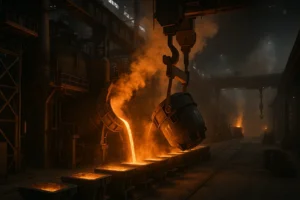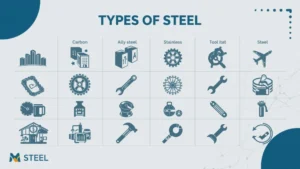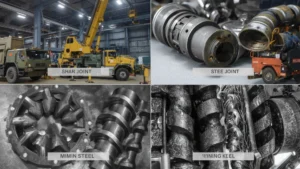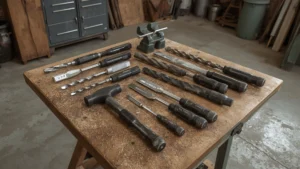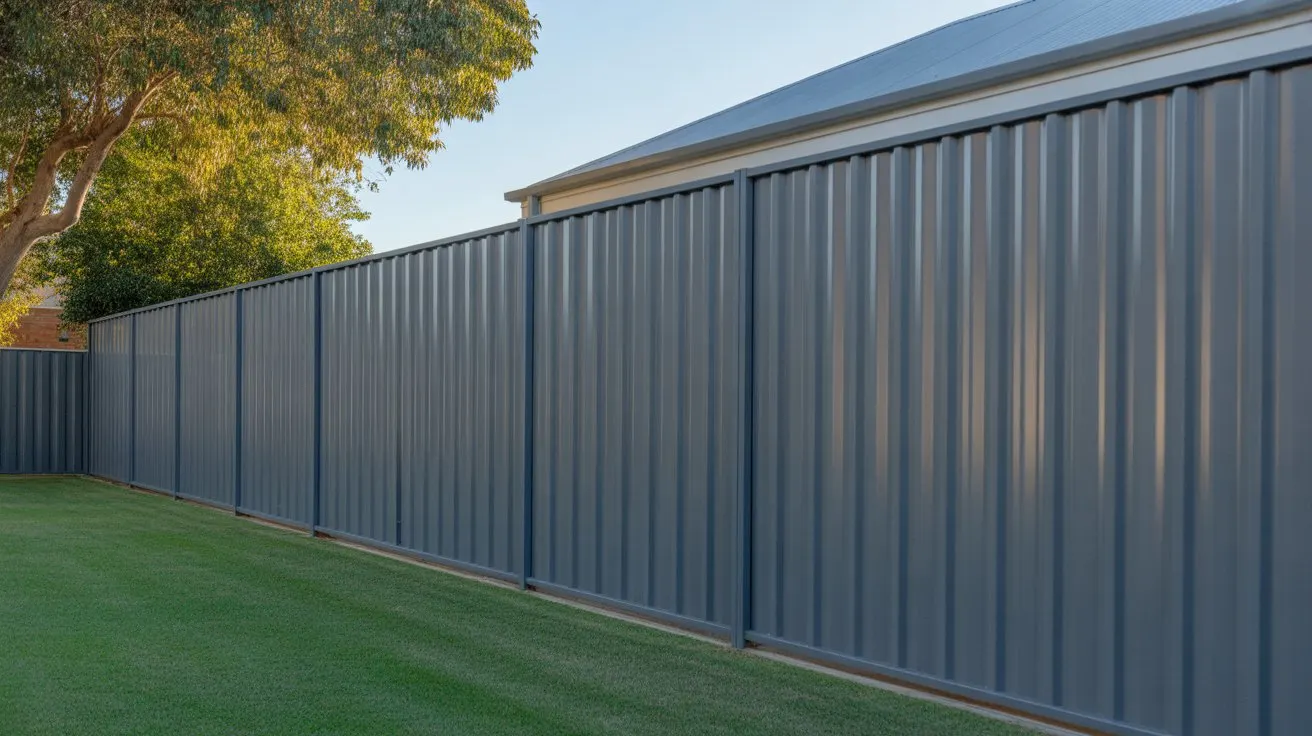There are many different types of steel, each offering unique properties based on its composition and use. Knowing the right type helps in choosing the most suitable material for specific applications. Steel is one of the most commonly used materials across industries. It combines strength, durability, and flexibility, making it ideal for everything from construction to household tools.
How Steel Is Manufactured
The steel making process begins with melting iron core in a blast furnace. Carbon and other alloying elements like chromium, nickel, or manganese and then added to form various grades of steel.
The final product is shaped into bars, sheets, or rods depending on its intended application. Carbon content and additional elements determine the steel’s strength, hardness, and resistance to rust.
Types of Steel by Composition
Steel is typically grouped into four major categories based on composition:
| Steel Type | Characteristics | Common Uses |
|---|---|---|
| Carbon Steel | Basic steel with varying carbon levels | Buildings, pipelines, machine parts |
| Alloy Steel | Enhanced with elements like chromium or nickel | Automotive, aerospace, heavy equipment |
| Stainless Steel | Contains chromium for rust resistance | Kitchenware, medical tools, appliances |
| Tool Steel | Designed for toughness and heat resistance | Drills, hammers, cutting equipment |
Each type offers different levels of strength, flexibility, and corrosion resistance.
Carbon Steel and Its Varieties
Carbon steel is the simplest form of steel. It contains iron and carbon, and it’s categorized based on its carbon content.
- Low Carbon Steel is soft and ductile, used in making wires and car body panels.
- Medium Carbon Steel offers better strength and is used in gears, axles, and mechanical parts.
- High Carbon Steel is very hard and ideal for cutting tools and springs.
These variations allow carbon steel to serve both lightweight and heavy duty applications.
Alloy Steel and Its Common Forms
Alloy steel is mixed with elements like nickel, manganese, and vanadium to improve mechanical properties.
- Nickel Steel provides high strength and is used in military hardware and cranes.
- Manganese Steel offers wear resistance, commonly used in mining and railway sectors.
- Chromium Steel has corrosion resistance and is found in automotive parts.
- Vanadium Steel is known for heat resistance and is often used in engine parts.
These enhancements make alloy steel suitable for demanding environments.
Grades of Stainless Steel
Stainless steel resists corrosion and is widely used in environments requiring cleanliness and durability.
- Austenitic Stainless Steel is the most common, used in cookware and industrial equipment.
- Ferritic Stainless Steel has low nickel content and is used in washing machines and boilers.
- Martensitic Stainless Steel is strong and hard, used in knives and surgical tools.
- Duplex Stainless Steel combines ferritic and austenitic features, offering high strength and corrosion resistance.
Stainless steel rust resistance and aesthetic appeal make it a preferred material in many industries.
Tool Steel for High Stress Applications
Tool steel is engineered to withstand high heat and impact. It’s used in environments that demand strength and wear resistance.
- Water-Hardening Tool Steel is commonly used in cutting tools.
- Air-Hardening Steel maintains its shape without needing water or oil to cool.
- Oil-Hardening Steel is tough and used for hand tools.
- Shock-Resisting Steel handles high impact, ideal for hammers and punches.
Tool steel is essential for manufacturing and metalwork industries.
Mechanical and Physical Properties of Steel
Steel is valued for its balance of mechanical and physical traits:
| Property | Description |
|---|---|
| Hardness | Ability to resist scratching and wear |
| Ductility | Can stretch without breaking |
| Strength | Can withstand heavy loads and pressure |
| Corrosion Resistance | Ability to resist rust and degradation |
| Density | Around 7.85 g/cm³ |
| Melting Point | Ranges from 1370°C to 1510°C |
These properties vary depending on the type and composition of steel.
Application of Steel in Various Sectors
Steel is used in nearly every industry due to its strength and versatility.
In construction, it supports buildings, bridges, and roads.
In the automotive sector, steel forms the vehicle’s body, engine, and suspension.
Household appliances like refrigerators and washing machines often contain stainless steel.
Medical tools rely on sterilizable stainless steel to ensure safety and durability.
These widespread uses show the vast application of steel across everyday life.
Industrial Use of Steel Varieties
Different industries rely on specific steel varieties customized to their operational needs.
- The oil and gas industry uses steel for pipelines and storage tanks.
- Aerospace applications require lightweight yet strong alloy steel.
- Shipbuilding relies on corrosion-resistant steel for ocean exposure.
Each industry benefits from choosing the right type of steel for its unique demands.
Environmental Impact and Sustainability
While steel production consumes energy and produces emissions, it’s also one of the most recycled materials.
Recycling steel reduces the need for raw materials and saves energy. Modern steel mills are moving toward greener technologies, including electric arc furnaces and carbon capture systems.
Sustainable practices are becoming a core part of steel manufacturing worldwide.
How to Choose Among Different Types of Steel
Selecting the right steel depends on several factors:
- Purpose: Determine what the steel will be used for.
- Budget: Some types are more cost-effective than others.
- Durability: Choose based on the strength or corrosion resistance needed.
Understanding the types of steal helps professionals make informed decisions in design and production.
Commonly Used Steel Types in Daily Life
Several types of steel are seen more often due to their wide usefulness:
| Steel Type | Primary Use |
|---|---|
| Mild Steel | Construction, gates, fences |
| Stainless Steel | Kitchenware, sinks, countertops |
| Tool Steel | Hand tools, chisels, and drill bits |
These materials are reliable, affordable, and versatile for both commercial and residential applications.
Innovations and Future Trends in Steel
The steel industry is advancing with lighter and stronger materials. Green steel, produced using hydrogen instead of carbon, is gaining attention.
Smart steel with built in sensors and nanostructured alloys are also being developed to meet future demands.
These innovations reflect the evolving role of different types of steel in a modern, sustainable world.
Final Thoughts
Steel remains a cornerstone of modern society. From skyscrapers to surgical blades, the different types of steel serve a wide range of uses. By understanding their properties and strengths, industries and consumers alike can choose the best steel for every application.
we specialize in delivering high quality steel solutions customized to the needs of modern infrastructure and manufacturing. With a commitment to excellence, precision, and reliability, we offer a wide range of steel products and fabrication services designed to meet the evolving demands of our clients across various industries.
Whether it’s mild steel for structural work or stainless steel for specialized equipment, AtoZ Fabrication Pvt Ltd stands as a trusted partner in every phase of your project ensuring quality you can count on.
Frequently Asked Questions
What are the main types of steel?
Carbon, alloy, stainless, and tool steel.
Which steel is most corrosion-resistant?
Stainless steel, especially austenitic grades.
Is steel recyclable?
Yes, steel is 100% recyclable without losing quality.
Where is alloy steel used?
In aerospace, automotive, and pipelines.
What’s the difference between mild steel and stainless steel?
Mild steel is softer and cheaper; stainless steel resists rust and is more durable.
Can different kinds of steel be used together?
Yes, but compatibility depends on their chemical properties.


